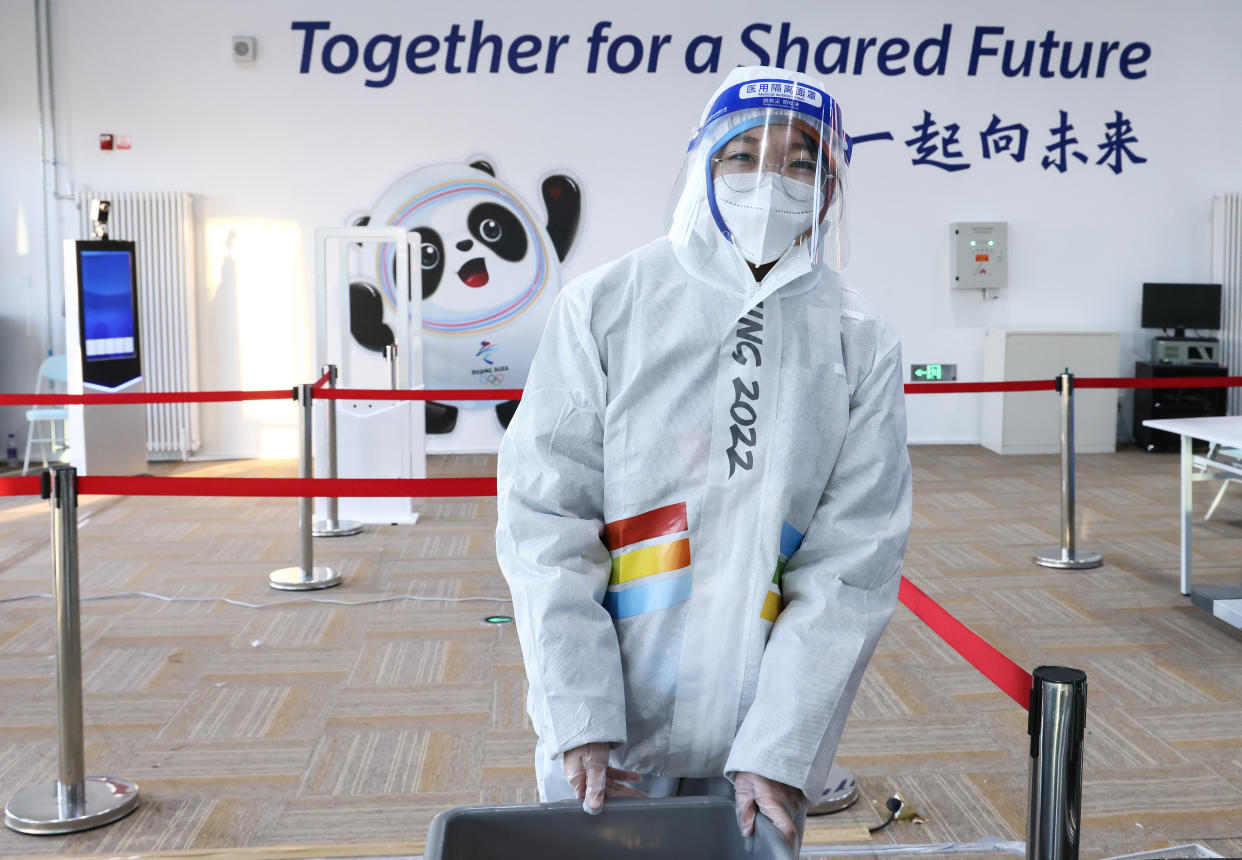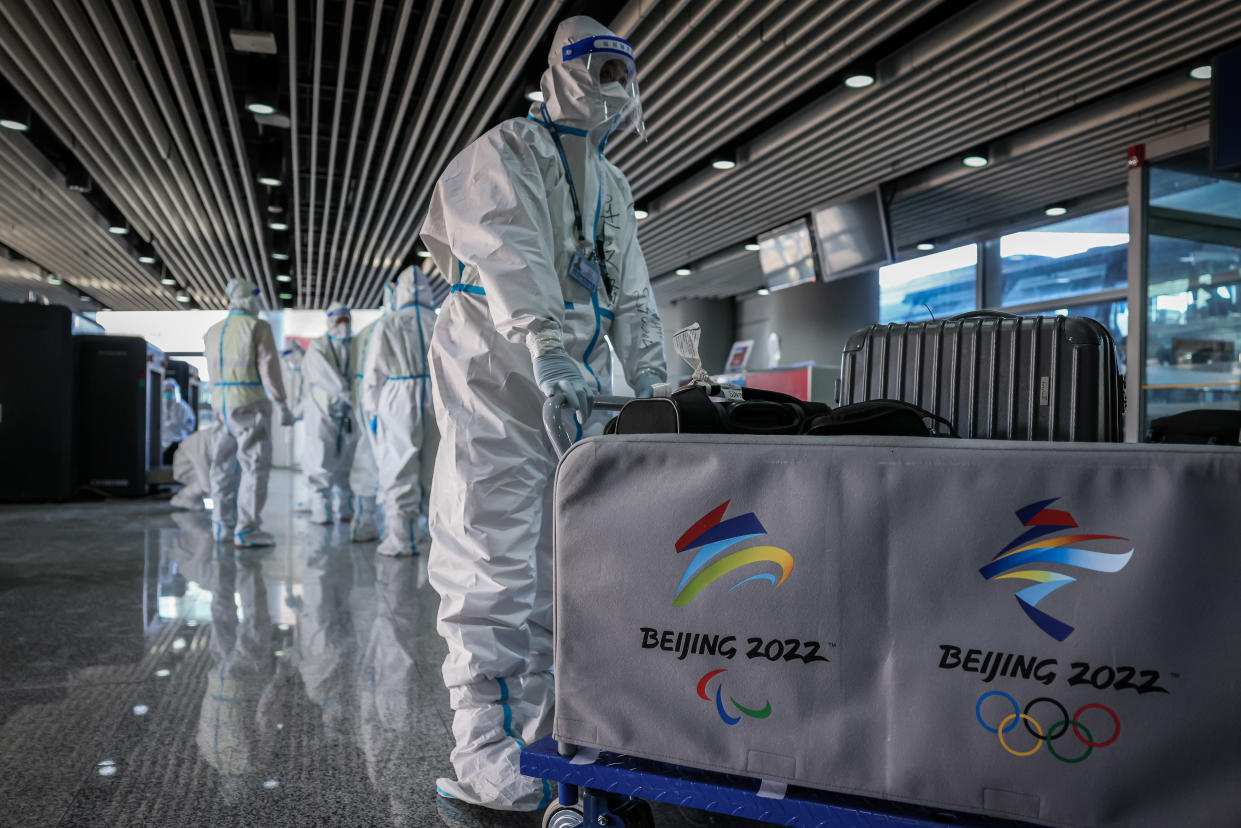The journey inside Beijing's 2022 Olympics bubble is long, painful and unsettling
BEIJING—“Relax,” the nurse says. But when the nurse is wrapped head-to-toe in a hazmat suit, and you’re sitting in an empty, echoing airport, and there’s a swab stabbing so deep in your brain it’s dislodging childhood memories, relaxation is tough to achieve.
Welcome to the 2022 Winter Olympics. The Games don’t officially begin until Friday night, but this much is clear: they will be chaotic and fascinating and a bureaucratic snarl. They’ll be inspiring and infuriating, a geopolitical exercise of soft power. But they will not be relaxing.
Years of preparation go into any Olympics, lifetimes of dedication to a craft so absolute that only a scant few ever reach the pinnacle. But 2022’s Olympics, like so much else in the COVID era, layers extra challenges and responsibilities atop the already-daunting task of reaching the Games. Invasive COVID protocols, extensive privacy and surveillance concerns, the personal debate of whether to use the Olympics as a platform for protest and awareness — China’s role as the host of these Games turned each of these into an existential, all-consuming question for everyone coming to Beijing for the Olympics … and that’s before you even focus on the task of doing what you came to China to do.
Some athletes have been preparing for Olympic logistics for months. “I’ve been training in Europe since November,” says Team USA biathlete Paul Schommer. “I’ve been asking before every situation, ‘What’s the smart thing to do here? Is it even smart to do this?’” He decided not to return home for Christmas, and spiraling Omicron numbers bore out the wisdom of his decision.
“Obviously it’s a big concern,” says American ski jumper Anna Hoffman. “We’re just making sure we’re following the COVID protocols. I’m thankful to have a team where everyone is committed to doing the right thing.”
Any journey to Beijing in 2022 is, best-case, a multi-day odyssey. China has closed its borders to most foreigners, and airlines have sharply cut back their routes to Beijing as a result. Some athletes, like ones from Team USA, were able to charter their own flights into China; others mixed in with the stream of officials, journalists and coaches hopscotching their way to Beijing via Paris, Tokyo or Hong Kong.
The journey begins before you board the plane
Long before anyone steps on a plane, though, they’ll need to prepare for the intensive, invasive, punitive China COVID protocols. A positive test has already vaporized many Olympic dreams before the torch is even lit. Once in China, testing positive, or even being in close contact to someone who has, means time in a Chinese isolation facility, which can range from annoying to heartbreaking.
Many people headed to the Olympics rolled back the clock to March 2020, quarantining and sectioning themselves off from a society that’s largely through with COVID even if COVID isn’t through with them. Others had to resort to best judgment, hope and prayer … and then test twice before getting on the plane.

For all travelers headed to the Games, the first test had to come up negative no more than 96 hours prior to the flight to Beijing. The second had to be within 72 hours — but it also had to be at a facility approved by the Chinese government, which meant that there were only a handful of facilities in major cities, and none at all in most of America.
Positive tests in hand, travelers submitted enough personal information to apply for five home loans, then waited for government approval and the generation of a specific QR code on their phones. No code, no boarding.
To shut down — not contain, not manage, shut down — COVID, China has constructed a “bubble” to enclose anyone coming to the Games and block them off from the greater Chinese population. This bubble technically began the moment travelers stepped onto the plane headed to Beijing, with surgical-grade masks mandatory and sanitation/decontamination measures present everywhere.
Still, as every parent knows, it’s easier to start with tough regulations and loosen up than the reverse, and some found the Chinese restrictions to be less fearsome than expected.
“I was pleasantly surprised. I was thinking we weren’t going to be able to get up, weren’t going to be able to eat,” says long jumper Casey Larson. “It was a lot more relaxed than that. It definitely exceeded expectations.”
This isn't America anymore
Once figures on the ground in Beijing become visible, it’s very clear this is no longer America. Everyone who comes in contact with international travelers in the airport is wrapped head-to-toe in white hazmat suits, faces covered, goggles and facemasks covering the only visible parts of their bodies — their eyes. It’s a surreal sight, and the merry drawings that decorate the suits — handwritten “Welcome to China!” messages, images of the Games’ mascots — do little to tamp down the unsettling vibe.
The Beijing airport only adds to the second-act-of-a-disaster-movie feel. Normally a bustling hub of activity, the airport is utterly silent — no music overhead, no ambient sound, only the footsteps of travelers following the directions of the hazmat-suited Chinese officials. A robotic, electronic version of “Fur Elise” that plays in the elevator is the opposite of comforting.

There’s that nasal swab; the earliest journalists through reported its severity on Twitter, and no matter how prepared you think you are, you’re not prepared enough. Then travelers are subdivided, more and more, into the three venues of the Games (two in the mountains, one in Beijing proper) and from there into the various hotels within the venues. Shuttle buses snap up a few travelers at a time, and anywhere from 4-8 hours after travelers land in Beijing, they reach their hotel rooms.
It’s a thoroughly systematized, mechanical, emotionless process … but eliminating the ability of any traveler to deviate from the prescribed route does have its advantages.
“I’ve had so much crappier travel days,” Larson says. “Worse layovers, lost luggage … there was none of that here. We spent a longer time than we expected on buses, but they were on new roads. It was all pretty relaxed.”
Welcome to the Olympic bubble
The “bubble” is more like a snake, threading its way right through the heart of Beijing and high into the surrounding mountains. Shuttle buses spread out from the airport — using special Olympics-only lanes, of course, a classic IOC demand — and wind their way through streets and countrysides plastered with the Olympic rings, 2022 logos, mascots and this year’s motto: “Together for a Shared Future.” Those within the bubbles aren’t anything close to together with the Chinese people, and that’s by design — welcome to China, now stay away from our people.
Hotels within the bubble have two airlock-style gates, some with concertina wire ringing the top of the fences. Scrims of snowflakes and mascots hide the heavy fences that surround each of the hotels and venues, and cameras capture every vehicle that enters and leaves every bubble building.
Even at the hotel, travelers’ journeys aren’t done. Off the bus, travelers are shunted straight into their rooms, where they’re told to wait until the results of that airport test come through. Some travelers have tape strung across their door; others just open their door to find a chair with a sign instructing them to wait. The call comes an hour or so after arrival, and from there it’s off to an isolation facility for the unfortunate few, or the true start of the Games for those who clear the first of tests that will await them every day they’re in China.
All of this, and the Games haven’t even begun. There’s no time at all to relax.
